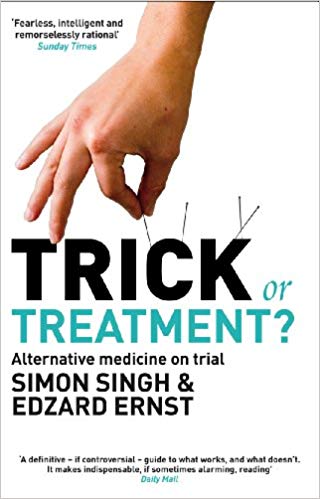
Publishing one excellent book is an accomplishment; publishing two in one year is a truly outstanding achievement. In 2008 Edzard Ernst and Simon Singh published a landmark book Trick or Treatment: The Undeniable Facts About Alternative Medicine. I reviewed it on this blog last summer. It is particularly important since Ernst is a former advocate for CAM(complementary and alternative medicine) who was able to objectively look at the scientific evidence and realize that it doesn’t support most CAM methods.
Before the year was out, Ernst had published another book, Healing, Hype or Harm? A Critical Analysis of Complementary or Alternative Medicine. It is a compilation of essays on various general and specific topics in CAM. Ernst is the editor; he and 15 other authors have contributed, mostly from the UK but also including Asbjorn Hrobjartsson from the Nordic Cochrane Centre in Denmark (the author of a landmark paper on placebos), Canadian health activist Terry Polevoy, and our own inimitable James (The Amaz!ng) Randi.
In the preface, Ernst says,
Our book tries to look behind the various smoke screens that tend to obstruct our vision and often prevent us from understanding the truth. The authors of this volume have very different backgrounds and views but they are all well-informed critics who do not dismiss CAM lightly. If they disapprove of certain aspects, they do so for well-argued reasons.
It covers many of the topics we have discussed on this blog. David Colquhoun tells a Crislip-type fable about the Department of Alternative Physics and Astrology replacing the old Department of Physics and Astronomy; then he shows how CAM has already infiltrated UK universities in exactly the same manner. Hrobjarttson discusses the importance and frailty of impartiality in CAM research. Michael Baum debunks the “holism” myth by eloquently describing two cases of breast cancer in pregnant women, where the scientific practitioner used knowledge at every level from the failure of DNA repair mechanisms in BRCA1 mutations at the molecular level all the way up to the understanding of a woman in her central role as mother, wife and member of a faith community, and considering her personal life story and fears. Leslie B. Rose describes the elaborate stepwise process of testing new drugs, from animal studies to phase I through IV human trials to post-marketing surveillance, and defines CAM as “a treatment which has not gone through this process, and in which we can have very little confidence that it works and is safe.” Other essays cover placebo, vitalism, patient choice, legal issues, politics and regulation, health care funding, homeopathy, chiropractic, and more.
In addition to providing interesting nuggets of fact and much food for thought, the book is a treasure trove of effective sound bites we can use in arguing these issues. Here is a sampling that I hope will pique your interest and persuade you to buy the book:
- [On the safety of CAM treatments] “Their inoffensiveness is often testament to their impotence.” And “There can be no effects without side effects.”
- “We need to be tougher in appraising conventional medicine, let alone the fringe stuff.”
- “Over the last few centuries, a process developed for separating fact from fiction, and it is called science…’the crash testing of ideas.’”
- “…scientific medicine has many failings, but alternative medicine offers no way forward in resolving them.”
- “Whereas traditional healers express humility in the face of nature and deference towards authority, practitioners of scientific medicine are skeptical and insubordinate…”
- “Just as reason cannot be reconciled with irrationality, so orthodox medicine cannot be integrated with alternative medicine.”
- “It is also ironic that patients who reject orthodox doctors as paternalistic resort to alternative practitioners whose appeal is largely based on personal charisma and the authority of ancient texts.”
- “Homeopathy is plain fraud… no real scientist believes it.”
- “The more harm a plant does to humans, the better its chance of survival.”
- “Barmy courses get barmy assessors so the process of accreditation provides no protection…”
- “Integrated medicine promotes CAM no matter what the evidence says.”
- “Is there any empirical evidence that vital forces exist? The answer is no, and how could there ever be? Is there any evidence that vital forces do not exist? The answer is no and how could there ever be? Vitalism generates no testable hypotheses.”
- “Concepts such as the qi of Chinese traditional medicine are myths which enjoy the same status as religious faiths. Believers cling to the myth despite the evidence, reinterpret the myth to suit the evidence, or lie about the evidence to support the myth.”
- “There is not a single, convincing example of a therapeutic synergistic effect between different components within a single whole plant extract… the examples usually cited all refer to mixtures of different herbs, to preclinical experiments or have not demonstrated that the observed effects are anything more than additive.”
- “The worst medical doctor can cure diseases and save lives; the best alternative healer can only offer false hopes.”
- “Patients have a right to benefit from both specific and non-specific effects. Placebos can at best generate non-specific effects, while effective treatments generate both specific and non-specific effects. It follows, I think, that administering treatments which are not demonstrably better than placebos is not in the best interest of the patient.”
There are many treasures in this book. Next week I will go into more detail about one essay that makes some very important points about the concept of “healing.”
This article was originally published in the Science-Based Medicine Blog
